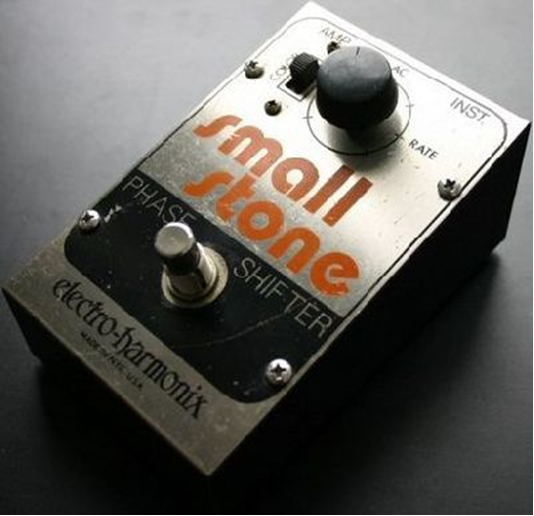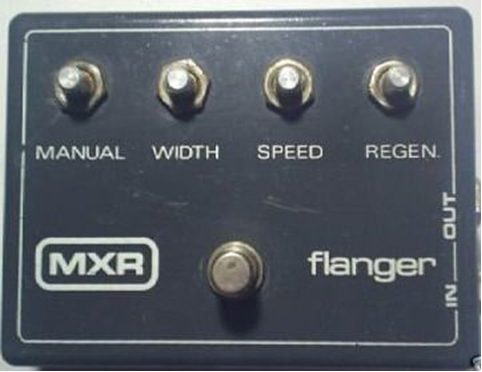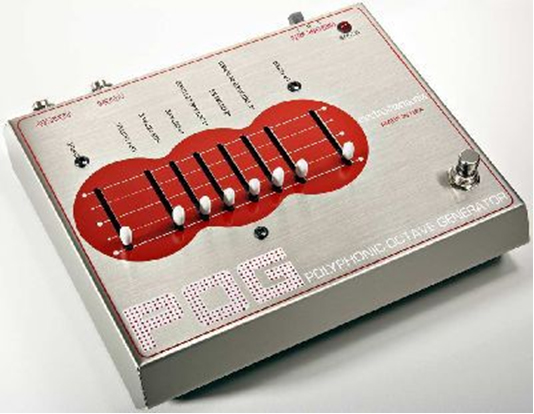The late 60s saw the arrival of some of music’s great innovators. Hendrix, The Beatles, and Zappa all used dramatic new effects to manipulate their traditional instruments. Newly available electronic devices from Electro Harmonix, Jim Dunlop and MXR allowed them to create weird new textures and evolving environments. These original pedals and rack units are now highly sought-after, and can change hands for surprising sums of money, but convincing emulations are included with most fully featured DAW packages. Though most of them were originally developed for guitars, they can often be put to good use on a synth or bass line.
Phaser
A Phaser effect, such as the Electro Harmonix Small Stone, delays an audio signal by a few milliseconds, by playing it through a bank of filters at prescribed intervals. The slightly delayed sound is then layered back over the original. This tiny, stepped delay creates a whooshing, sweeping effect as the sources overlap. Each time the signal passes through the filter bank again, the relative distance between the two signals shifts, stretching the delay and causing the sound to constantly shift and mutate.

The EH Small Stone was a favourite of Jimi Hendrix
The dreamy, evolving tone sounds great added to a soft synthesizer pad. It generates some interest in what would otherwise be a static sound, creating some movement and dynamics and the Phaser shifts through the frequency band.
Flanger
The flanger can be thought of the Phaser’s angrier cousin. It performs a similar process, doubling the signal and playing back a shifted version over the original. But rather than a bank of stepped filters, the Flanger transposes signal as a whole, creating a more uniform effect, with a harsher, more “robotic” overtone. A Flanger applied to monosynth lead creates a classic “Electro” sound reminiscent of Kraftwerk or Justice.

Because of the static state of a Flanger, it’s possible to duplicate the effect using a standard digital delay unit. Just set the delay time to around 10 milliseconds, and adjust the LFO control to hear the jarring effect. In the analog days, producers such as The Beatles’ George Martin would create this effect by playing a song on two identical tape machines, then pressing lightly on the flanges of one of the reels to slow one of the machines down. Hence the name “Flanging,” a term coined by Lennon in the studio.
Octaver
The octaver pedal is a less commonly heard effect on traditional rock music, as it wasn’t as popular upon its release. However, effects such as the EH POG (Poly Octave Generator) are hugely popular amongst retro synth and new wave acts. The effect listens to the frequency of the input signal and generates a synth tone at that same frequency. The circuit then shifts the signal to an octave below or above the original sound. It’s great for fattening up bass-lines or adding an additional dimension of tonal complexity to a lead part. If you use a drum machine with independent outputs for each sample’s sound, running your kick drum through an octaver can add some serious sub-bass weight.

High-end units such as the POG generate multiple copies at once, each in a different octave, and use volume sliders to control the prominence of each, allowing the creation of a complex, multi-tonal layered effect.
Ring Modulation
This is one of the most dramatic effect sounds, and is at its most useful if you’re trying to get “like, really out there…” Ring Mods use a complex electrical circuit that blends different frequencies together mathematically, creating a buzzing, stuttering sound. If you’ve never heard a Ring Modulator in action, one of their most famous uses is to create the robotic voices for the Daleks in TV’s “Dr. Who.” It is often mislabelled as a “Noise Synth” because of the harsh metallic scraping sound it creates.

The Moog Moogerfooger is a stand-alone version of the ring mod unit built-in to their famous analog synths
There is a huge scope for incorporating some of these unusual effects into your music, especially if you think a little outside the box. Run your drum loops through a ring modulator and bypass it so there’s no effect, then momentarily click it one when you reach a fill or crescendo. The clanging metallic racket adds drama and aggression. Subtle use of phasing on acoustic drum tracks can accentuate the movement within a loop of slinky funk. The music legends who popularized these effects fifty years ago got there by experimenting until they found something that sounded weird and alien. With a little exploration of the outer reaches of normalcy, you can add a twisted new dimension to your tracks too.




